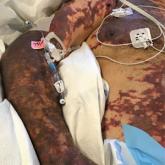Article

Purpura Fulminans in an Asplenic Intravenous Drug User
- Author:
- Emily S. Nyers, MD
- Rachael H. Kappius, MD
- Laura S. Winterfield, MD
- Dirk M. Elston, MD
In patients with severe purpura fulminans and a gangrenous limb, it is important to allow adequate time for demarcation of gangrene and not rush...
